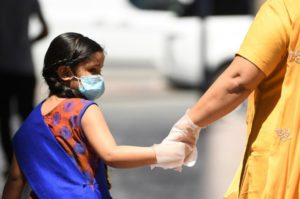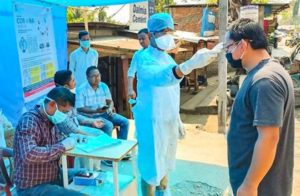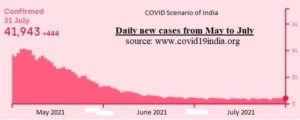India & World UpdatesBreaking NewsFeature Story
With low sero-prevalence, is Assam ready to take on the third-wave? writes Dr. Sabyasachi Roy
As the third wave is said to be round the corner, we also need to orient our psychology and tailor-make our approach to fight Covid head-on

//Dr. Sabyasachi Roy//
The fourth serological survey (sero-survey) conducted by ICMR during June and July 2021 across 21 states of the country has given a relieving signal. Presently, sero-prevalence in India is showing a convincing figure of 67%, on an average. This number is much higher than the result of the third sero-survey (conducted during December 2020 and January 2021) which recorded 21.5% of adult Indians having antibodies. This, seemingly, should take us to a comfort zone, but there remains some more concerns in this vast country with the robust population of 135 crores.
 Sero-prevalence means percentage of individuals in a population who have antibodies to the infectious virus. Sero-prevalence survey (or sero-survey) measures the antibodies in the blood samples collected from different parts of the country, and by extrapolation puts forward a picture of the prevailing situation and predicts the future trait. After this fourth sero-survey, this jump from 21.5% to 67% in sero-prevalence within six months is an indication of surge towards herd immunity, some experts say. Another brighter side is that, in this fourth sero-survey, ICMR has also tested blood samples of children between 6 and 17 years – of which more than half were found having antibodies.
Sero-prevalence means percentage of individuals in a population who have antibodies to the infectious virus. Sero-prevalence survey (or sero-survey) measures the antibodies in the blood samples collected from different parts of the country, and by extrapolation puts forward a picture of the prevailing situation and predicts the future trait. After this fourth sero-survey, this jump from 21.5% to 67% in sero-prevalence within six months is an indication of surge towards herd immunity, some experts say. Another brighter side is that, in this fourth sero-survey, ICMR has also tested blood samples of children between 6 and 17 years – of which more than half were found having antibodies.
 With 67% sero-prevalence, it can be assumed that two-third of Indian population have already developed antibodies, through exposure or through vaccination. However, with 19% of the populace having single-shot vaccination in July (4% fully-vaccinated) and with total number of confirmed cases accounting for only less than 3% of the total population, this 67% having antibodies for the pathogen signals that most of the rest, about 45%, have developed antibodies directly through contracting the virus, of whom there has been no official record.
With 67% sero-prevalence, it can be assumed that two-third of Indian population have already developed antibodies, through exposure or through vaccination. However, with 19% of the populace having single-shot vaccination in July (4% fully-vaccinated) and with total number of confirmed cases accounting for only less than 3% of the total population, this 67% having antibodies for the pathogen signals that most of the rest, about 45%, have developed antibodies directly through contracting the virus, of whom there has been no official record.
 Also, there remains more than 40 crores people who are still acutely vulnerable. Also, the scenario of this sero-prevalence is not uniform across the length and breadth of the country. Among the states, Madhya Pradesh (79%), Rajasthan (76.2%) and Bihar (75.9%) are having highest sero-prevalence, whereas Kerala (44.4%), Assam (50.3%) and Maharashtra (58%) are weakest on it.
Also, there remains more than 40 crores people who are still acutely vulnerable. Also, the scenario of this sero-prevalence is not uniform across the length and breadth of the country. Among the states, Madhya Pradesh (79%), Rajasthan (76.2%) and Bihar (75.9%) are having highest sero-prevalence, whereas Kerala (44.4%), Assam (50.3%) and Maharashtra (58%) are weakest on it.
| States with highest sero-prevalence | States with lowest sero-prevalence |
| Madhya Pradesh (79%) | Maharashtra (58%) |
| Rajasthan (76.2%) | Assam (50.3%) |
| Bihar (75.9%) | Kerala (44.4%) |
For Assam, with vaccination rate higher than the country-wide average (25.9% of population of Assam have had at least one shot compared to 19% for India), this lower seroprevalence is a matter of concern for the state. The half of the population of the state is presently vulnerable to the virus.
 Further, for Assam, although the positivity rate has dipped below 1% recently, the fatality rate is much higher (1.54% to 1.92% for the last five days) than India-average which is just above 1% for the last few days. So, with some inspiring rays of hope, there are also some issues of concern and as such there is no room for complacence.
Further, for Assam, although the positivity rate has dipped below 1% recently, the fatality rate is much higher (1.54% to 1.92% for the last five days) than India-average which is just above 1% for the last few days. So, with some inspiring rays of hope, there are also some issues of concern and as such there is no room for complacence.
 Furthermore, at the wake of relaxation of the COVID protocols in the state, people are showing lax and have started crowding at public places disregarding COVID protocols. Scientists and doctors are warning repeatedly that such negligence might invite the apprehended third wave. Most importantly, this is worth remembering that no vaccine is having 100% efficacy and can give full protection in contracting the virus. Although, as per CDC, double vaccination results in very low viral load in case of infection (after two weeks of second vaccine dose), but in most of such cases affected persons remain asymptomatic and unknowingly become silent spreaders. The continuous mutation of the virus is also another grave concern.
Furthermore, at the wake of relaxation of the COVID protocols in the state, people are showing lax and have started crowding at public places disregarding COVID protocols. Scientists and doctors are warning repeatedly that such negligence might invite the apprehended third wave. Most importantly, this is worth remembering that no vaccine is having 100% efficacy and can give full protection in contracting the virus. Although, as per CDC, double vaccination results in very low viral load in case of infection (after two weeks of second vaccine dose), but in most of such cases affected persons remain asymptomatic and unknowingly become silent spreaders. The continuous mutation of the virus is also another grave concern.
 There is another issue of concern put forward by AIIMS Director Dr. Dr. Randeep Guleria. As per his statement given in an interview to NDTV a couple of days back, the present R-value of the pandemic growth has crossed 1.0 very recently, inching up from 0.96. This R-value is a key factor in gauging the coronavirus pandemic. It refers to the ‘effective reproduction number’ of COVID-19. An R value of 1.0 is a crucial threshold. With its exponential growth, a R-value even slightly over 1.0 can lead to a large number of cases in a very short time if not contained judiciously.
There is another issue of concern put forward by AIIMS Director Dr. Dr. Randeep Guleria. As per his statement given in an interview to NDTV a couple of days back, the present R-value of the pandemic growth has crossed 1.0 very recently, inching up from 0.96. This R-value is a key factor in gauging the coronavirus pandemic. It refers to the ‘effective reproduction number’ of COVID-19. An R value of 1.0 is a crucial threshold. With its exponential growth, a R-value even slightly over 1.0 can lead to a large number of cases in a very short time if not contained judiciously.
 For Indian scenario, it is indeed tough to formulate a reliable epidemiological model, as data reflects very strange behaviour of the proliferation of virus chain. A long plateau has been continuing since mid-June till today, perhaps sharp peak is awaited!
For Indian scenario, it is indeed tough to formulate a reliable epidemiological model, as data reflects very strange behaviour of the proliferation of virus chain. A long plateau has been continuing since mid-June till today, perhaps sharp peak is awaited!
 With waxing and waning of COVID waves in the last one and a half year, India, including Assam, has experienced acute to severe situations. All attempts to fight back, including continuous augmentation in the strength of health services, have fallen short at the engulfing pattern of the spread of the contagious pathogen. This angst echoed in the words of Dr. Guleria as he emphasized again on ‘test, track, treat’ mantra relying on the basic epidemiolocal philosophy of ‘breaking the chain.’
With waxing and waning of COVID waves in the last one and a half year, India, including Assam, has experienced acute to severe situations. All attempts to fight back, including continuous augmentation in the strength of health services, have fallen short at the engulfing pattern of the spread of the contagious pathogen. This angst echoed in the words of Dr. Guleria as he emphasized again on ‘test, track, treat’ mantra relying on the basic epidemiolocal philosophy of ‘breaking the chain.’
 Attaining herd immunity in a country of 135 crore populace is arduous, but not impossible if all stake-holders do their bit appropriately. We need to follow, in letter and spirit, the advisories issued time to time by the Government. As the virological and physical nature of the pandemic is changing and as the third wave is said to be round the corner, we also need to orient our psychology and tailor-make our approach to fight it head-on – for the sake of our family, our neighbours, our society and above all for our country.
Attaining herd immunity in a country of 135 crore populace is arduous, but not impossible if all stake-holders do their bit appropriately. We need to follow, in letter and spirit, the advisories issued time to time by the Government. As the virological and physical nature of the pandemic is changing and as the third wave is said to be round the corner, we also need to orient our psychology and tailor-make our approach to fight it head-on – for the sake of our family, our neighbours, our society and above all for our country.
(Dr. Sabyasachi Roy is Associate Professor of Karimganj College)





